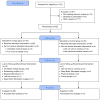Community-based Argentine tango dance program is associated with increased activity participation among individuals with Parkinson's disease
- PMID: 22902795
- PMCID: PMC3557593
- DOI: 10.1016/j.apmr.2012.07.028
Community-based Argentine tango dance program is associated with increased activity participation among individuals with Parkinson's disease
Abstract
Objective: To determine the effects of a 12-month community-based tango dance program on activity participation among individuals with Parkinson's disease (PD).
Design: Randomized controlled trial with assessment at baseline, 3, 6, and 12 months.
Setting: Intervention was administered in the community; assessments were completed in a university laboratory.
Participants: Volunteers with PD (n=62) enrolled in the study and were randomized to a treatment group; 10 participants did not receive the allocated intervention, and therefore the final analyzed sample included 52 participants.
Interventions: Participants were randomly assigned to the tango group, which involved 12 months of twice-weekly Argentine tango dance classes, or to the no intervention control group (n=26 per group).
Main outcome measure: Current, new, and retained participation in instrumental, leisure, and social activities, as measured by the Activity Card Sort (with the dance activity removed).
Results: Total current participation in the tango group was higher at 3, 6, and 12 months compared with baseline (Ps≤.008), while the control group did not change (Ps≥.11). Total activity retention (since onset of PD) in the tango group increased from 77% to 90% (P=.006) over the course of the study, whereas the control group remained around 80% (P=.60). These patterns were similar in the separate activity domains. The tango group gained a significant number of new social activities (P=.003), but the control group did not (P=.71).
Conclusions: Individuals with PD who participated in a community-based Argentine tango class reported increased participation in complex daily activities, recovery of activities lost since the onset of PD, and engagement in new activities. Incorporating dance into the clinical management of PD may benefit participation and subsequently quality of life for this population.
Copyright © 2013 American Congress of Rehabilitation Medicine. Published by Elsevier Inc. All rights reserved.
Figures







References
-
- Lang AE, Lozano AM. Parkinson’s disease. First of two parts. N Engl J Med. 1998;339(15):1044–53. - PubMed
-
- Adler CH. Nonmotor complications in Parkinson’s disease. Mov Disord. 2005;20 (Suppl 11):S23–9. - PubMed
-
- Martinez-Martin P, Schapira AH, Stocchi F, Sethi K, Odin P, MacPhee G, et al. Prevalence of nonmotor symptoms in Parkinson’s disease in an international setting; study using nonmotor symptoms questionnaire in 545 patients. Mov Disord. 2007;22(11):1623–9. - PubMed
-
- Shulman LM, Gruber-Baldini AL, Anderson KE, Vaughan CG, Reich SG, Fishman PS, et al. The evolution of disability in Parkinson disease. Mov Disord. 2008;23(6):790–6. - PubMed
-
- Tison F, Barberger-Gateau P, Dubroca B, Henry P, Dartigues JF. Dependency in Parkinson’s disease: a population-based survey in nondemented elderly subjects. Mov Disord. 1997;12(6):910–5. - PubMed
Publication types
MeSH terms
Grants and funding
LinkOut - more resources
Full Text Sources
Other Literature Sources
Medical
Miscellaneous

